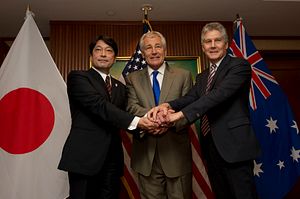Japan’s cooperation with Australia, which began with much fanfare in 2006, has been given added momentum and impetus in recent years by the combined efforts of Japanese Prime Minister Shinzo Abe and Australian Prime Minister Tony Abbott. This is a significant development in the region’s security architecture, as Australia is only the second nation with which Japan has sought to build such a security relationship – just after the relationship established with the U.S. in 1952. At the launch event for a Stimson Center publication in Washington, D.C., experts weighed in on the origins and future of the Japan-Australia relationship.
As recently as 2010, James Schoff points out, it was the U.S.-Japan-South Korea security dialogue that Japan really prioritized. Back then, with North Korea’s nuclear test, the sinking of the Cheonan, and the shelling of Yeonpyong island, this trilateral structure was the more dynamic and clearly-defined security relationship. However, as the historical baggage began to weigh down Japan-South Korea cooperation, the U.S.-Japan-Australia security dialogue — which was based on “fuzzier premises,” and had a broader range of priorities and disconnected initiatives — began to gain importance in 2012.
Though this trilateral relationship is often talked of in terms of countering the rise of China, that is not the main purpose, Schoff argues. Even now, China’s role in spurring trilateral cooperation is something that Japan keeps bringing up, but the U.S. and Australia continue to resist. Instead, the trilateral relationship was driven by a policy change in Washington — and by Japan and Australia’s desire to keep the U.S. engaged in the region during times of uncertainty.
Schoff clearly lays out the different priorities that each of the three states place on the relationship. Japan wants trilateralism as a deterrence instrument, as something that can give it strategic flexibility. Australia sees the opportunity through an operational perspective: Australia wants to expand joint exercises and deepen institutional connections. What the U.S. cares the most about is regional architecture building. In short, Japan’s interests not withstanding, the focus of U.S.-Japan-Australia cooperation will continue to be “order-centric” rather than “threat-centric.”
One means by which the Trilateral Strategic Dialogue (TSD) can justify its existence as an “order-centric” institution is to engage in humanitarian assistance and disaster relief (HA/DR). Within the TSD, David Envall explains, HA/DR has become more than symbolic tokenism; it is an important and sophisticated instrument by which the TSD shows its utility as an institution that does more than just “containment.” The rhetorical value and legitimating function of HA/DR will only increase over time as regional rivalries intensify.
However, all in all, the TSD is increasingly driven by strategic concerns, meaning that it is turning from non-traditional concerns — such as counter-proliferation, counterterrorism, and disaster relief — to more traditional areas. This is manifested in defense equipment cooperation between Japan and Australia, which Yuki Tatsumi studies, and the trilateral coordination of policies and aid toward Southeast Asian states engaged in island disputes with China in the South China Sea. As Ken Jimbo notes, the U.S., Japan, and Australia are likely to increase military-to-military cooperation with Southeast Asian states, and focus on strategic investment by using Official Development Aid (ODA) for security purposes.
Japan and Australia will continue to cooperate with each other and the U.S. in order to keep the U.S. engaged in the Asia-Pacific. If they can keep the focus on “order-centric” activities or perhaps, more importantly and even trickier, successfully message their activities as “order-centric,” then the U.S.-Japan-Australia TSD will contribute to a more stable and prosperous Asia-Pacific.
































